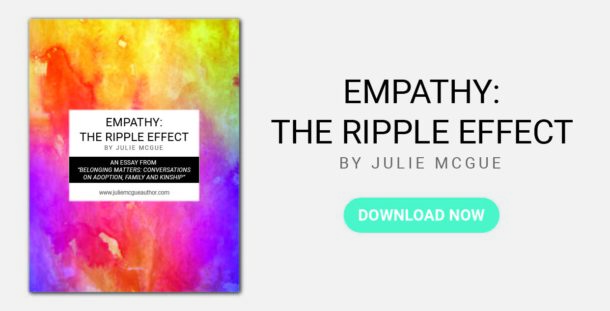Adoption As Regifting

Julie McGue
Author
By definition, regifting is repurposing, transferring a gift to someone that was previously received from someone else. A strict caveat with regifting is that one must always make certain that the ‘regift’ recipient isn’t in the same social circles as the original ‘gifter’.
Doesn’t that sound like adoption?
Ok, it may be a stretch to lump the complexity of adoption into a simple idea such as regifting, but stay with me as I work through my analogy. The original gift, in the case of adoption, is the child. The original receiver of the gift/child are the birth parents, (In the Baby Scoop Era of the 60s & 70s, often the birth father was not apprised of the child he fathered; furthermore, his rights were not recognized as needing to be surrendered. The current legal system requires that if the father is known, he must sign away his rights.) For a multitude of reasons the receiver/birth parent turns over the gift/child to be transferred to other recipients. Essentially, the birth parents regift the child to the adoptive parents, thus being relieved of an unwanted or inconvenient present.
Inherent in my conjecture here is that the gift does not ever have a say-so in being transferred or regifted. Like an inanimate object, an infant has no ability to reason, no capability to object, and is not conscious of their rights. It is others, adoption’s gatekeepers, that determine who receives the regift. As receivers of the regift, adoptive parents are often desperate for the gift/child. Most have been waiting for years and are willing to pay for the privilege of being selected as recipients. Don’t we all love to receive a gift?
The adoption process assumes that the folks facilitating the regifting/adoption have the gift/child’s best interests in mind. Let me remind you again about the main rule in regifting: the gift/child should be regifted to a recipient in a different social circle. In the Baby Scoop Era when I was adopted, adoption gatekeepers were cognizant and careful to do this. Adoptees went to families outside the immediate circle of the birthparents. The social workers and adoption agencies were careful to align ethnicity, religion, and appearance. The thinking being that the more an adopted child resembled the adoptive family, the more easily they fit in; thereby, not calling attention to the fact that they were adopted. In that era, birthparent’s feared being known as a regifter. For the adoptive parents receiving the regift was joyful, but it highlighted embarrassing infertility issues. Both giving and receiving were high stakes propositions.
Should there be other rules for regifting?
In the case of adoption, there must be limits imposed on regifting. When an item is regifted more than once, (I would pose that a child in the foster care system might fall into this category) it becomes a bit weary or damaged due to over-handling. In the white elephant gift exchange that I mentioned above, there are rules. A gift can be stolen from a recipient twice before it is considered ‘dead’ or out of commission. In the case of adoption, a child is rarely returned to the adoption agency or birth parent, but in the foster care system this abuse is systemic. As an adult adoptee, it is my belief that there should be a set of rules for adoptive and birth parents. Communication between all parties that benefit the needs and wants of the adoptee should be implemented. Gifts don’t usually have a say-so in who they ultimately belong to, but in the case of children their right to information about the regifter is integral to their development.
This analogy of adoption as regifting may be oversimplifying a complicated situation, but on a basic level it has merit. In regards to the foster care system, repeatedly placing a child in multiple homes highlights the serious nature of more than one round of regifting. Whatever you want to call it, regifting or transferring, the effects of being passed around to multiple sets of parents/receivers is damaging to the child/gift and needs an overhaul.
Whether you buy into adoption as regifting or not, remember this: every child is a gift. Therefore givers, receivers and gatekeepers must carefully consider the ramifications of adoption/regifting as it relates to a child’s development and wellbeing. Finally, I maintain that adoption or regifting should always be a last resort. Reconsider your gift, make room for it in your life, and reap the rewards that come with receiving.
“Whether you buy into adoption as regifting or not, remember this: every child is a gift.”

Snag my in-depth reference guide to best equip you for the journey ahead.



0 Comments